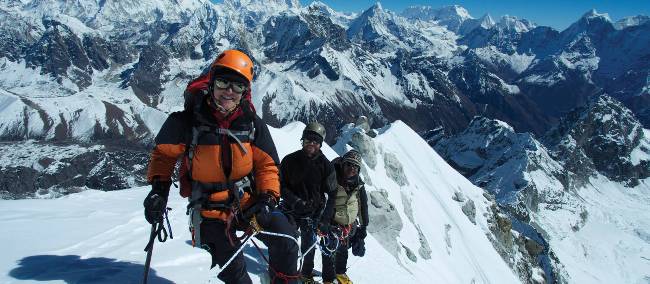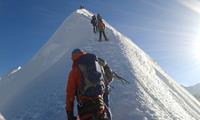
Ascending Kyajo Ri with spectacular views of the Himalaya | Tim Macartney-Snape
Blog home / Climbing Gear Essentials with Tim Macartney-Snape
With any World Expeditions trip that has a climbing option comes comprehensive trip information, including what climbing equipment you need to bring. Here is a brief description of that gear and why you need it, direct from our resident expert mountaineering legend Tim Macartney-Snape.
Prusik Loops
Prusik loops are an important bit of climbing gear that allow the user to easily and safely ascend a rope. They can also be used like a ‘moveable knot’ on a rope - a feature that is very useful in crevasse rescue.
Ideally you will have two Prusik loops, tied from ‘kernmantle’ nylon cord of 5mm diameter into a short and long loop.The short loop can also be used as a back-up device whilst rappelling and is useful when travelling roped up on a glacier to act as a ready to use, adjustable anchor point on the main rope. They also can come in handy as back-up slings.
On most World Expeditions trips it would be extremely unlikely that you would ever have to climb up a rope using your prusiks, but they are useful to have just in case. We recommend 6 metres of 5-6 mm cord. Larger diameter cord is unnecessarily heavy and works less well. It’s important that the length of the loops is cut and tied to suit the user’s arm length. As a rule of thumb, the short loop when tied (using a double fisherman’s knot) should be about the length from your shoulder to the elbow, while the long loop should be just shorter than the length of the whole arm.
If in doubt, your guide will always help you make the loops. As with all knots, always make sure with the double fisherman’s knot that there is at least 30mm of the rope end sticking out of the knot, this is because when put under a lot of force, a knot will always cinch up and if the cord end is too short, it can slip back into the knot with the unwelcome possibility of it undoing.
Carabiners

Carabiners are used to quickly attach safety slings or equipment to a rope or fixed anchor. They come in two varieties - plain gate and locking gate.
On most trips four plain and two locking carabiners will be sufficient. For locking carabiners we recommend the Black Diamond Magnetron. Because of their lighter weight, alloy rather than steel ones should be used.
Descender/belay device
A dual purpose piece of climbing gear. We recommend the Black Diamond ATC. If you already own a figure 8 device it will do the job, but they do have a tendency to twist the rope. An ATC is also easier to lock off for belaying or descending.
Ascender
The ascender is an essential piece of climbing gear that is used to easily and safely ascend steeper sections of fixed rope. Unless otherwise stated, one is sufficient for most World Expeditions trips. We recommend Petzl or Kong types.
Harness

A lightweight special purpose mountaineering harness is best, because it will be lighter and you will be able to undo the leg loops whilst still being safely tied in. If you already own a rock-climbing harness it will do the job, but it will be more convenient if it has leg loops that can be undone.
Slings
Sewn webbing climbing slings are used as a safety backup on fixed ropes and to attach your rucksack to an anchor if needed. Two 60cm nylon or dyneema/spectra slings will do the job well. Some people may have or wish to buy other items of essential climbing equipment that, for Nepal trips, are included in your trip cost.
Ice Axe

The ice axe is indispensable if you plan to venture out onto extended snowy slopes exposed to large drops - along with crampons (see below). The ice axe’s main role is to use in arresting a fall, but is also used as an extra hand-hold and walking staff on steeper ground. For normal mountaineering, a lightweight, straight-shafted one is far the best kind.
Some more technical axes that have a slightly bent shaft will also do the job well, as long as they are lightweight. A straight or slightly convex-curved pick (curving up at the tip) is best.
Crampons
A modern general snow and ice style crampon with front points, clip on attachment with anti-snow balling plastic on the base is best. Stainless steel is the preferred material, as it will not rust. Lighter alloy crampons are unsuitable.
Helmet

Comfortable and lightweight are the two main criteria for a good mountaineering helmet. A nice bright colour is a good safety feature, as well as looking good in photos!
Where to shop for climbing gear
Purchasing a full kit of climbing gear can be as fun as a kid let loose in a candy store, but it can also empty the wallet! Most of our Himalayan climbing expeditions come with a Gear Package, containing crampons, ice axe, harness and helmet.
To help you build your own gear collection, all clients booking through our Australian offices will receive a 15% discount voucher from our friends at Paddy Pallin and those of you who book through our office in London receive the same amount of discount with Cotswold Outdoor & partners.
Where to put your climbing gear into action
There are so many amazing mountaineering destinations around the world, for every experience level.
Check out our mountaineering trips to start planning your dream adventure.